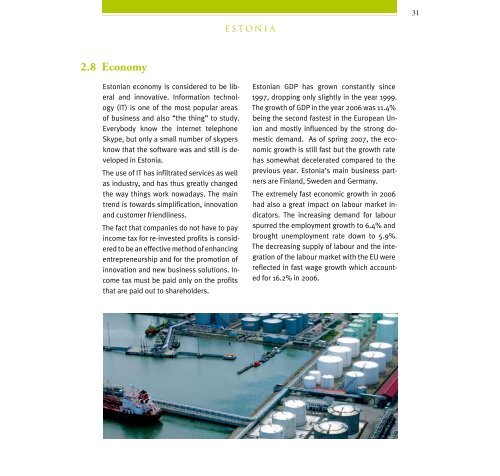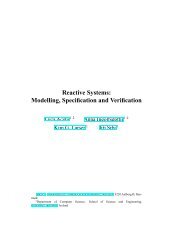Visiting Researcher's Guide - EURAXESS Estonia
Visiting Researcher's Guide - EURAXESS Estonia
Visiting Researcher's Guide - EURAXESS Estonia
Create successful ePaper yourself
Turn your PDF publications into a flip-book with our unique Google optimized e-Paper software.
2.8 Economy<br />
<strong>Estonia</strong>n economy is considered to be liberal<br />
and innovative. Information technology<br />
(IT) is one of the most popular areas<br />
of business and also “the thing” to study.<br />
Everybody know the internet telephone<br />
skype, but only a small number of skypers<br />
know that the software was and still is developed<br />
in <strong>Estonia</strong>.<br />
The use of IT has infiltrated services as well<br />
as industry, and has thus greatly changed<br />
the way things work nowadays. The main<br />
trend is towards simplification, innovation<br />
and customer friendliness.<br />
The fact that companies do not have to pay<br />
income tax for re-invested profits is considered<br />
to be an effective method of enhancing<br />
entrepreneurship and for the promotion of<br />
innovation and new business solutions. Income<br />
tax must be paid only on the profits<br />
that are paid out to shareholders.<br />
ESTONIA<br />
<strong>Estonia</strong>n GDP has grown constantly since<br />
1997, dropping only slightly in the year 1999.<br />
The growth of GDP in the year 2006 was 11.4%<br />
being the second fastest in the European Union<br />
and mostly influenced by the strong domestic<br />
demand. As of spring 2007, the economic<br />
growth is still fast but the growth rate<br />
has somewhat decelerated compared to the<br />
previous year. <strong>Estonia</strong>’s main business partners<br />
are Finland, sweden and Germany.<br />
The extremely fast economic growth in 2006<br />
had also a great impact on labour market indicators.<br />
The increasing demand for labour<br />
spurred the employment growth to 6.4% and<br />
brought unemployment rate down to 5.9%.<br />
The decreasing supply of labour and the integration<br />
of the labour market with the EU were<br />
reflected in fast wage growth which accounted<br />
for 16.2% in 2006.<br />
31

















